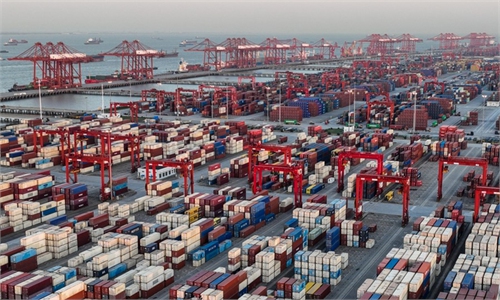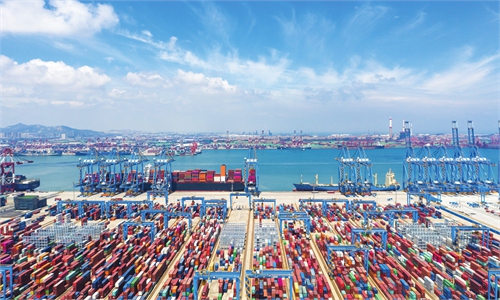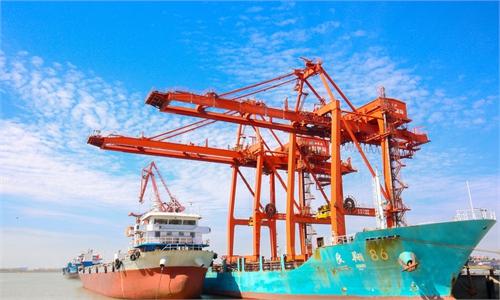
China-made automobiles are waiting for export at the port of Yantai in East China's Shandong Province on October 14, 2024. China's total trade reached 32.33 trillion yuan ($4.57 trillion) in the first three quarters of 2024. Exports of the "new three" items - electric vehicles, lithium batteries and photovoltaic products - accounted for 4.1 percent of total export value. Photo: VCG
China's total trade reached 32.33 trillion yuan ($4.57 trillion) in the first three quarters of 2024, setting a record high with an increase of 5.3 percent year-on-year, the General Administration of Customs (GAC) said on Monday, noting that foreign trade maintained steady growth and the trade structure continued to optimize.
While external and internal challenges remain, there is still a solid foundation for China's foreign trade to maintain stable growth in the final quarter of the year, thanks to the growing competitiveness of Chinese products and strong policy support, officials and experts said.
As exports remain one of the biggest growth drivers for China's economy, strong growth in the fourth quarter of 2024, will continue to provide strong support to ensure that overall economic growth will remain stable, experts noted.
Strong growth
In the first three quarters, China's total exports amounted to 18.62 trillion yuan, growing by 6.2 percent year-on-year, while imports reached 13.71 trillion yuan, an increase of 4.1 percent, according to officials at a GAC press conference on Monday.
"Overall, China's foreign trade operations remained stable in the first three quarters, with exports and imports both showing growth," Wang Lingjun, deputy head of the GAC, told the press conference.
Wang said that while the domestic and international environments are becoming more complex and China's foreign trade development faces some challenges, the fundamentals of China's economy, along with its vast market, strong resilience and great potential, remain unchanged.
"As current policies and new measures continue to take effect, positive factors for foreign trade development have accumulated. There is a strong foundation for steady growth in imports and exports in the fourth quarter," Wang said.
Zhou Maohua, an economist with China Everbright Bank, told the Global Times on Wednesday that despite an increasingly complex external environment, China's foreign trade in the first three quarters performed "better than expected," and played a supportive role for economic growth.
Beyond the strong growth in total trade, there were many highlights in China's imports and exports in the first three quarters of 2024.
China's trade with the Belt and Road Initiative partners hit 15.21 trillion yuan, an increase of 6.3 percent year-on-year in the first three quarters, accounting for 47.1 percent of China's total foreign trade during this period, according to the GAC.
China's trade with other members of the Regional Comprehensive Economic Partnership increased by 4.5 percent in the first three quarters, while that with the Association of Southeast Asian Nations surged by 9.4 percent.
Meanwhile, China's private enterprises achieved an import and export volume of 17.78 trillion yuan in the first three quarters, marking a growth of 9.4 percent year-on-year, which was 4.1 percentage points higher than the national average growth, according to the GAC. Private companies contributed 93.8 percent to China's overall trade growth, continuously injecting new vitality into the nation's foreign trade development, the GAC data showed.
Underscoring China's continuously optimizing trade structure, over the first three quarters, exports of the "new three" items - electric vehicles (EVs), lithium batteries and photovoltaic products - reached 757.83 billion yuan, accounting for 4.1 percent of total export value, according to the GAC.
Amid China's surging exports of EVs and other advanced products, some countries have sought to impose protectionist restrictions. At the Monday press conference, Lü Daliang, a GAC spokesperson, said that the imposition of tariffs by some countries is an unfair and unreasonable practice of trade protectionism.
China's export of the "new three" items not only enriches global supply and alleviates inflationary pressure but also significantly contributes to global efforts to combat climate change and promote green transformation, Lü said.
Rising competitiveness
Also responding to a question about certain countries' concern over China's huge trade surplus at the press conference on Monday, Wang said that China has never deliberately pursued a trade surplus. Behind the recent expansion of the goods trade surplus, there are factors such as the improvement of the competitiveness of China's industries and the stronger export resilience, as well as the impact of the recent decline in global commodity prices, which has lowered the value of imports, Wang said.
Li Yong, a senior research fellow at the China Association of International Trade, said that the strong trade data pointed to the continuously rising competitiveness of China's trade sector, which helped the country greatly counter external challenges, including the so-called decoupling attempts by the US.
"While the external environment has become more complex, external demand for Chinese products remain solid," Li told the Global Times on Monday. "In other words, Chinese products remain so competitive for consumers in many countries and regions that artificial attempts to decouple cannot succeed."
Notably, trade with the US rose by 4.2 percent, while that with the EU grew by 0.9 percent, according to the GAC data.
Chinese experts remain confident that foreign trade will maintain stable growth despite external challenges. "Uncertainties remain in the external environment, but given the unchanged demand for Chinese products, I don't see any reason that China's foreign trade would slow down," Li said.
Bai Ming, a research fellow of Chinese Academy of International Trade and Economic Cooperation, also said that despite external uncertainties ranging from rising protectionism and monetary policy changes, there is still plenty of room for growth in China's foreign trade in the fourth quarter of 2024, which will continue to offer strong support for economic growth.
"Given the relatively high growth rate, foreign trade is clearly a driving force for, instead of a drag on, China's overall economic growth," Bai told the Global Times on Monday, noting that various policy measures put in place to support the foreign trade sector will help ensure stable growth in the fourth quarter.
Exports are one of the top three driving forces for China's economic growth. China's GDP expanded by 5 percent in the first half of 2024, and Chinese officials are expected to release third-quarter GDP data later this week.




